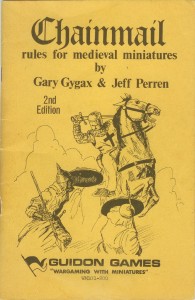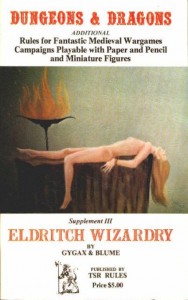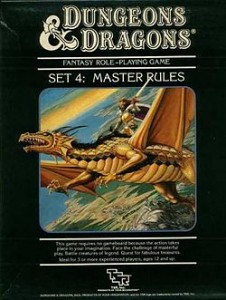If you have players who memorize every D&D supplement but won’t read your ten pages of campaign background, try this: organize your game world’s history around D&D editions.
I’ve mentioned that you can use the game year to denote what edition you’re running. Thus, if you’re playing 4e, your game is set in the Fourth Age, and the year is, say, 413. If you decide you’d like to try a first-edition campaign, you could play in the year 113, in the First Age of the same campaign world. Here’s a sample D&D history that would work in a lot of campaigns. You can weave your own campaign events around this chassis.
PRIMORDIAL AGES:
 This is the realm of prehistory, before adventurers delved, and before humans were the dominant species on the earth. Here you can slot in millennia of rule by gods, demons, aboleth, god-emperors, chainmail-clad armies of giants, elves who ruled from Avalon Hill, and what have you.
This is the realm of prehistory, before adventurers delved, and before humans were the dominant species on the earth. Here you can slot in millennia of rule by gods, demons, aboleth, god-emperors, chainmail-clad armies of giants, elves who ruled from Avalon Hill, and what have you.
During this time is the fabled Golden Age – a time of great wealth and civilization, when platinum coins were minted and when all those +1 swords were forged. The people of the Golden Age guarded their treasures with the technological mechanisms so often found in dungeons: gas traps, teleporters, elevator rooms, etc.
ORIGINAL AGES: Also called The Old Age or the Zeroeth Age. If you play OD&D, you’re adventuring in this time setting. In this era, swamps are filled with dinosaurs, and deserts are filled with Mars creatures like tharks. The Original Age can be further subdivided into ten epochs, based on the OD&D and Basic supplements: the Age of Origins, Age of Greyhawk, Blackmoor, Eldritch Wizardry, Demigods, Basics, Experts, Companions, Masters, and Immortals, each with its own historical events based on the new rules introduced in that supplement. For instance:

In my campaign: In the Age of Eldritch Wizardry, elven experimentation with psionics triggered a disaster that turned their home into a ruin-covered desert. Many elves still live in the ruins, where they fight a constant battle with ghouls (thus, elven immunity to ghoul paralysis and secret-door abilities).
FIRST AGE: You adventure in this age if you’re playing 1e AD&D.
In the First Age, orc tribes established their own lands, and half-orcs became more common. Bardic colleges were established. Gnomes immigrated, bringing illusion magic with them. Humans first explored the underdark and met the drow, planar travel was perfected, and the Tomb of Horrors was built.
SECOND AGE: The epoch of second-edition rules.
City-states became great empires. New lands were discovered and carved up into nations. By the end of the age, many of the empires had become decadent, and were plagued with financial problems.
In the third age, wizards took control of the crumbling empires. Prestigious warrior, religious, and wizard organizations became more important than nations. There was a proliferation of martial skill training traditions. Magic item shops were first established. In this age, the first warlock pacts were made.
FOURTH AGE: 4e and Pathfinder.
The great nations of the Second Age finally fell. Nothing was left but small communities, points of light against the darkness. Many ancient traditions were lost, including the old ways of magic first taught by Vecna. New traditions arose. Magical paths were discovered to the Feywild and the Shadowfell. In the chaos, there were many emigrations: tieflings and dragonborn arrived from faraway islands and deserts, and many civilized folk, seeking to preserve their old traditions, set sail on ships to a new continent. They called themselves the Pathfinder Society.
FIFTH AGE: It’s currently the beginning of the fifth age and we don’t know how it will turn out. So far, it seems to be a time where democracies flourish: for the first time, city-states are beginning to determine their laws by vote. Like all ages, it will probably be a time that mixes great advances with tragic errors.
And that’s as far as you can play, unless you get these RPGs:
DRAGON AGE: Some future century will be called Dragon Age, and, according to the game’s subtitle, it will be a time of Dark Fantasy.
THIRTEENTH AGE: Prophecy has it that the last age before the end of the world will be the Thirteenth Age. In that time, the Thirteen Icons will wage a final war for the fate of the world. (I hope that official D&D won’t get to 13th Edition for quite some time, so I’ll give this one to Tweet, Heinsoo, and company.)









Hah! nice idea. There was blog (“Save or Die!”) that started developing a campaign world where the material in the little brown books, supplements, Dragon magazines, etc were incorporated chronologically as if they were events in the game world, so for example at first the adventurer’s guild refused to train dwarves and elves over a certain level, but later relented and raised the level caps; thieves began adventuring alongside fighting men, clerics, and m-us; martial arts developed to take better advantage of weaponry (variable damage by weapon type rather than d6 for everything); monsters evolved as their HD and stats changed between the LBB and Monster Manual, and so on. A very entertaining read.
Very awesome idea!
How about the continuing Basic sets and Rules Cyclopedia? Perhaps there was a hidden isle where the monks of the Mentzer Order compiled lost knowledge through the First and Second Ages, until their library was destroyed by the proud Wizards of the Third Age.
Also during the Second Age, the orders of assassins and monks disappeared for some reason, while warrior guilds devised a complex mathematics of warfare revolving around the newly invented number “Zero”.
What a great idea! I intend to steel this idea for my own campains. This should work well for time traveling campains.
I’m sorry, but every edition after the 2nd edition AD & D rules was a crass attempt to make money on behalf of WotC. They weren’t trying to improve the game, they were just wanting to fill their pockets.
Anyone who fell for it is a suckface.